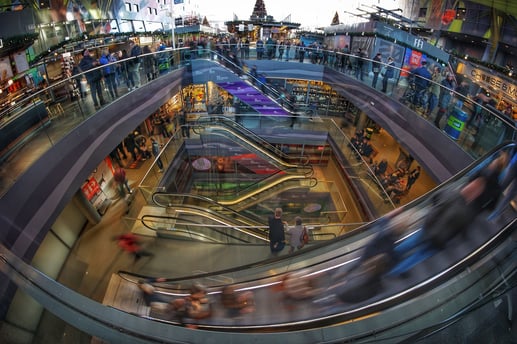No matter a venue’s purpose or location, there are bound to be all sorts of emergency incidents that occur. Whether that be weather-related events, active intruders, medical emergencies, or even the presence of dangerous animals. It is the responsibility of the organization to keep their constituents informed of emergencies and provide guidance as to the actions to be taken in the case of an emergency. This responsibility is synonymous to having fire alarms in your building, the display of exit plans, and the accompanying drills.
With people coming and going, public assembly venues are a particular challenge when it comes to safety and security. Traditionally, public spaces make use of a public announcement (PA) system. However, PA systems are only as effective as they are audible. For visitors who are deaf or hard of hearing, this method of communication would fall flat. Even for hearing-abled individuals, a PA system is not effective by itself. In a loud and crowded place, it might not be the case that visitors can detect an important notification. Take, for instance, a shopping mall. It might be that the PA system is not located throughout stores but present only in the common spaces. In any case, tenants and visitors can easily miss a critical message, have it be muffled, and not know what to do when a warning is issued.
People gather at venues like auditoriums, arenas, convention centers, exhibit halls, stadiums, museums, cultural & performing arts centers, zoos & aquariums, houses of worship, and amphitheaters to broaden their minds spiritually, emotionally, and intellectually. They seek to enhance their knowledge of different topics from science and history to musicals and plays by attending events or exhibits. The expectation is to learn and enjoy in a safe environment free from harm and injury. These types of venues are often busy. And, more often than not, have an extremely transient population. The efficient spread of information is even more important when we take into consideration that children also frequent these facilities. It is the responsibility of the organization to provide a safe place for each person to visit. Owning or managing a venue requires preparation before, during, and after an emergency takes place.
Exhibits or shows are often changing in hopes to bring in different crowds of people with different interests. There are also schools and classes that use these facilities to enhance or extend the education of their students. During emergency response planning, many venues struggle with the question - “How am I able to alert such a transient group of people whose contact information I do not have?”
The answer is multimodality - or Omnimodality - as we call it. Having a mass notification system that allows you to send alerts through multiple channels to notify your people of an emergency is the only option. When you have new patrons coming in the door every single day there’s no other choice. You will not reach each person with just a text message or email. Each individual comprehends information differently, so sending alerts through multiple avenues such as email/text, PA Systems, digital signage, emergency notification apps, social media posts, and even audible and visual alarm systems is so important. Having your employees and volunteers registered to receive these notifications and guidance via text is critical. They should be trained to assist those visitors. Remember, those visitors may not be trained or even aware of what is happening.
In light of the past decade’s numerous mass shootings, more and more people recognize the need for safety precautions and additional security measures. Still, many don’t understand the efficacy and effectiveness of a mass notification system — they may not even know that these systems exist. And they may not realize that a mass notification system is much more than a text messaging system.
Today’s public and private venues represent communities unto themselves. Large or small, each is a bustling slice of society that serves a diverse and transient population of people as they live, learn, pray, and play. As a result, venue safety officials must concern themselves with all the potential threats to the people who comprise their entire community — staff, visitors, children, and the larger community.
Venues are also a place of gathering and being together. In a venue such as a place of worship, members expect to attend their services - as well as other events - in a welcome, peaceful environment. Unfortunately, hateful and harmful events have occurred over the last few years which have caused concern for the safety of practicing religions in a sanctuary — or a safe refuge for those who need time for prayer and reflection. What was once considered a safe haven must now prepare for unthinkable emergency situations. This leaves religious leaders with the task of keeping everyone in their house of worship informed and educated for different emergency Scenarios.
Religious venues are known for being ‘always open’ and accepting of those in need of help, but they must also look out for themselves. It’s time that these houses of worship develop an emergency action and response plan. Time and energy must be spent on preparation and automation of emergency response. “It’ll never happen to us”’ is no longer a valid excuse.
Shopping centers like malls or outlet centers are constantly crowded throughout the year. Not only are these places you go when you want to go shopping, but these are also places you go to dine, see a movie, and even spend time with friends or family. Because these types of venues are so frequented, it’s imperative that these locations have a system that allows them to not only keep their constituents safe but also their tenants and workers. With the cyclical shopping trends, not only do shoppers fluctuate but so do store staff — adding workers during peak shopping seasons. With this challenging retail turnover, it can be difficult to familiarize everyone with the safety and security measures set for the facility. Using a mass notification system with omnimodality helps venues like shopping centers and malls get the word out as needed to notify everyone — even if they do not have those people’s contact information.

Dustin Jensen, the Public Safety Manager at West Acres Shopping Center located in Fargo, North Dakota, uses unique groups in his mass notification system. Separating his organization into groups allows him to better control whatever situation might come his way. “We have different groups set up, to include a group that will reach all 700 individuals in the system. We also have groups set up for each emergency function — operations, security, media, as well as for mall management. The depth of the Omnilert system is just great; it really allows us to fulfill our communication needs.” It’s imperative for Jensen, in a public venue like a mall that has thousands of visitors and workers each day - that he be able to communicate emergency messages through more than just a PA system. Jensen is able to send alert to telephones, mobile phones, social media, their website, and desktop computers — which he says is an essential part of any emergency notification system or mass notification system.
Emergencies do not happen on a clock. They can happen at any time, anywhere, and there is no one-size-fits-all solution. Be proactive and prepare. You cannot continue to live the “that’ll never happen at my facility” mentally. The truth is that you don’t know if it will or won’t. The only precaution you can take to protect your organization and your people is to prepare for every emergency scenario that might happen. And then keep people in-the-know when one does occur.
Each venue is unique in its own way, and their notification methods should align to the communication channels that are in place with the purpose of reaching the most amount of people in the shortest amount of time. You must take time to analyze the possible emergency situations and make a plan with actions for your people and patrons to follow.
Take a look at how these unique venues - Dewees Island and West Acres Shopping Mall - are investing in the safety of their employees, patrons, and visitors. You’ll get insight into what challenges they face and how they prepare their emergency notification and response and their people.

